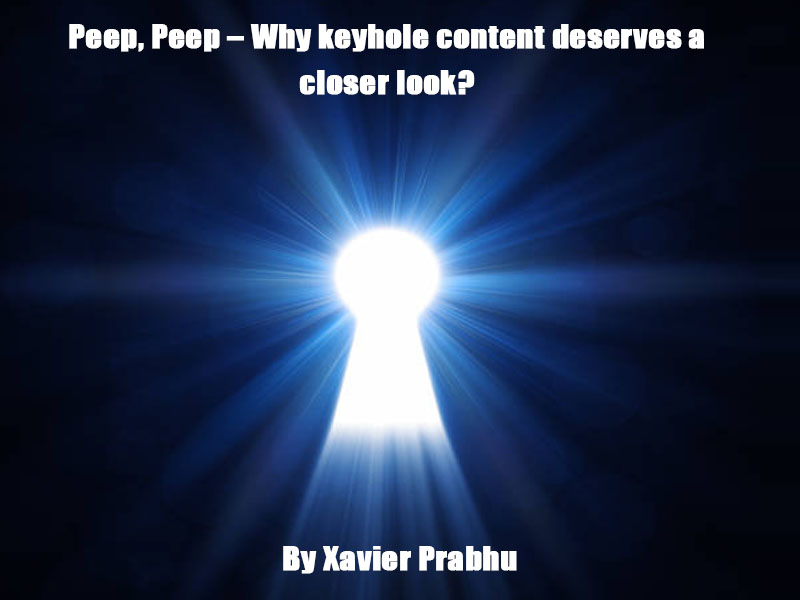PRHUB Integrated Marketing Communication Pvt Ltd 14 Jun 2017 // 1:35PM GMT

Even if it is a slight exaggeration, recent news reports of Justin Trudeau staging a well-choreographed run past waving youngsters, triggered this article. How much ever The Guardian slams him, there are millions out there who like what he is doing, even if they know he is staging it. They like the fact that he tries to let them into a Prime Minister’s life and persona unlike others, about whom we have to wait for leaked stories and authorized (or unauthorized) biographies. In today’s lingo, he is killing it, and he can truly be called a “Keyhole” content hacker.
Now, let me quickly explain the term. It’s called keyhole because it’s still a closed door and you don’t tell or see everything. It has been proven repeatedly in the recent past that an “auratic gap” between a personality and his audience/fans is important in building the right “interest” around that person. Keyhole content in the gossipy, tabloid style has been around for long, and it is something that really sells all time. It has largely been restricted to actors, models, personalities and politicians etc. It is also something that one cannot openly express admiration of, as it’s perceived to be not “there” from an intellectual perspective. For most PR and corporate communication professionals, it has been a no-go area since time immemorial, for most of us have been taught that good, credible brands require exactly that – good, credible communication. Some of us may also have our noses and chins up considering it sleazy even. Nevertheless “keyhole” content is here to stay, and it need not mean what it is widely and popularly known to be. Let me without further ado, jump into why it is relevant?
Combine all that we know of millennials/even younger audiences with increased centrality of social/digital… They are switching off standard, heavy content, like – the most advanced, cutting-edge technology that seeks to make each of our lives blah… blah…, faster than Bolt in a 100 meter dash. More importantly, they hate it and over its repeated occurrence label brands communicating in this manner as “not there” or boring. Leave millennials out. Have seen older, mature audiences snigger at such content. Beyond simplicity, all of us are seeking something much more – an emotional connect that “keyhole” content provides. Mark Zuckerberg famously observed that this generation likes to live its life out there, and all it cares about is what’s happening in other’s lives. What makes us think that this does not apply to brands/organizations and key people in those organizations (loved the picture of Obama holidaying with Branson in his private island though am not the typical peeping tom)? Consumers across ages, even more so the younger ones, have a keen interest in knowing bit more, not so staple, about what really happens inside.
Content, even good content is just exploding; we all need a new sauce… Once upon a time there was content and we just consumed it without knowing, it was content. Then came “content marketing” with its attendant hype, and now we have good, bad and ugly content hurled at us from every possible platform, asset etc. Lots of brands and organizations are today producing good, sensible content than ever before. You know what that means. There is too much of good content out there as well. So how about interspersing that good content with some inside view content?
Anyways it is happening and will happen more… This is the reality for all of us, and it may not be just big brands or known companies anymore. Have maintained for some time now that, more parts of corporates and brands is a glasshouse than ever before (haven’t we all seen the picture of a senior female white house staff sitting casually on a sofa right inside the oval room recently, which tells us a lot more about the new culture or the leader at the core of the culture than long stories can? Or the picture of Melania Trump brushing away the US President’s hand during their Israel visit.). Or scoops by insiders, or just out ex-employees about the misogynist or bad work culture in some of valley’s largest and hottest ventures? (take the case of Uber where Susan Fowler’s blog started it all). These are brand communication whether you see it that way or not. Whether you agree, disagree, like it or not, and these subtle, candid ones are more powerful and far more etched in a consumer’s or reader’s mind than any other communication is. Am not exactly recommending any of us to try a Justin Trudeau either.
Let me now, quickly make an important point as well as clarity – “It definitely is not for all brands and spokespersons”. Not everyone is Virgin and Richard Branson, and in a lighter vein, not everyone is Donald Trump either. Keyhole content is more relevant for certain brands, or those operating in certain sectors, which by nature needs to engage and weave the consumer into the brand story. For business to business, and those in highly regulated and sensitive sectors, it is more challenging, but one should not entirely rule it out. There may be occasional opportunities even for these companies to allow an inside peek. Anything more than that will be a disaster and not worth the effort.
Now, here are some of the flip sides:
What if this leads to craving for more of keyhole content? This is a very real possibility, and for brands and communicators alike, this is scary. There are two ways to handle this and not fix it (hope you got the subtle but significant point am making here). Ensure that you set up a calendar of such content flow mixed deftly into your overall communication calendar, and secondly set up clear boundaries. And up the ante on the quality of the other content that you put out. To reiterate “keyhole” by definition, is not unfettered free for all view, but a restricted voluntary view that we allow.
The Spokespersons - Not all spokespersons carry themselves well or lend to this. Have heard many insiders tell me that some of the “reel” hot personalities are not so in “real” life. Very few can carry it off like a Branson or an Obama. But when you have a spokesperson who can, please use it to the optimal. In instances where they can be nudged and helped, do give it a shot. Please remember that they need to come across as “what they need to come across as.” If there are any doubts, shut the whole effort down and take the regular, well-trodden path.
What if this backfires? - The probability of backfiring is as real and equal in “keyhole” content as to having a press conference or a tough journalist interaction. Is the ROI finally worth the additional risk, would be a good question to ask and my answer is both a “Yes” and a “No”.
Now, to some real advantages for brands, organizations and spokesperson who get it right and are open:
It is good for brands, organizations and leaders to let in… Many are going to identify with your brand, organization or its leaders for the two potential troublesome folks looking to leverage or corner you because of it. That identification or association is very genuine, voluntary and likely to be longer lasting and deeper. It is a trade-off and as long as being communicators, we know, understand and balance these trade-offs well, it is fine.
It makes our job less watchdogs and more facilitators… One thing a lot of journalists and public loathe in PR and communication staff, is the wall we throw around or are perceived to build. It makes many think that there is a lot, or something to hide. Like a start-up founder recently confessed at an event on a panel in Bangalore (India), he got more goodwill in admitting to goofing up than brickbats. Of course it is more complex for listed, large global companies, but it isn’t undoable.
It connects well to the new reality in a largely social and digital world - Even the most private ones know their lives to an extent (lesser than others) is up on the web in some form or other, not much farther from the prying eyes of Mr. Google and others. Millennials and the new generation are born into and revel in it. When your brand allows them to think or have a much closer view, they do remember and differentiate that brand.
It is a long road ahead and know for sure that not all questions can be answered. But my submission is that, it is a road all of us need to walk on at some point or the other, or learn how to walk on. The earlier, the better. The better, the more engaging and differentiated your brands and organizations are.
----------------------------------------------------------------------------------------------------------------------------------------
Xavier Prabhu, the author of this article is Founder & Managing Director, PRHUB, one of India’s leading independent, full service PR firms that have significantly progressed on the “New PR” value proposition and has built multiple specialized capabilities in-house. He can be reached at [email protected]


































.jpg)












